New To Indian Cooking? These Are The Chef-Approved Spices To Stock Up On
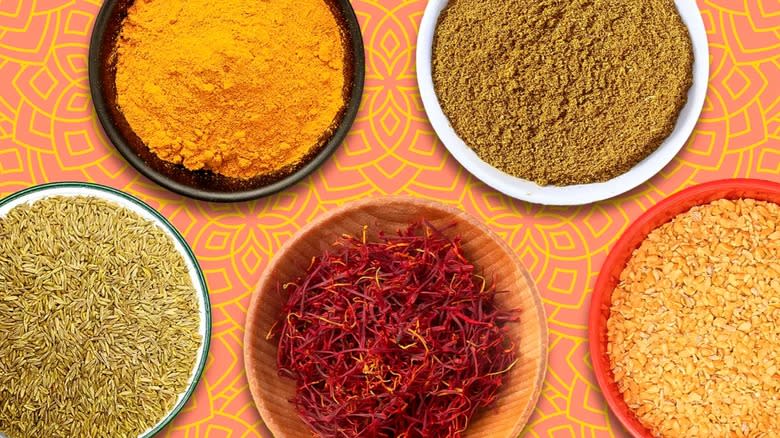
Indian cooking is one of the most vibrant and influential cuisines in the world, beloved not just in South Asia but the world over for its rich flavors, regional diversity, and the spices it has introduced to the world. Like any cuisine of such depth and breadth, it can be extremely intimidating to people from outside the culture who are trying to learn how to cook it. Even popular Indian dishes that are more familiar to Westerners, like chana masala or vindaloo, are packed with complex spice mixtures that make it hard for newcomers to understand what each one is contributing. But you need to start somewhere, and there are plenty of spices used in Indian cooking that you can easily get in most supermarkets that will help introduce you to the delicious possibilities of the cuisine. So Tasting Table reached out to an expert, celebrity chef Varun Inamdar, to ask which are the best spices for an amateur to stock up on.
Inamdar provided us with a list of 10 spices to have on hand for basic Indian recipes, and gave us some advice on what dishes they are most useful in. Almost all of these are familiar and easy-to-find yet essential ingredients for Indian cooking, and they'll ease you into the kinds of flavors familiar to South Asia. You'll also come to quickly see how much Indian ingredients have influenced cooking around the world in the process.
Read more: Styles Of Regional BBQ In The US
Mustard Seeds
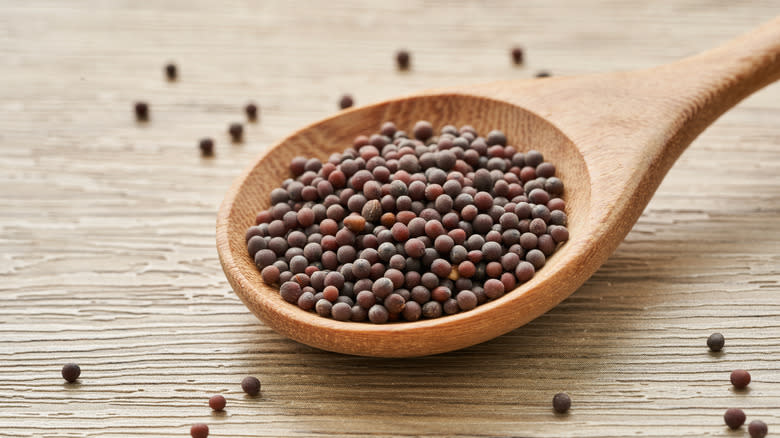
Mustard in all its forms is one of the most popular flavors in the world, but for Indian cooking it's not the condiment, or even usually the powder you're dealing with, but whole mustard seeds themselves. Varun Inamdar tells us that mustard seeds are used "for tempering lentils, some vegetables, rice preparations, chutneys, and raita." Mustard seeds come in three common styles of decreasing pungency in Indian cooking — black, brown, and white — but black is the most commonly used and the one you should start with. They bring that classic peppery zing to a dish, and when cooked whole they also add a nice crunchy texture.
As Inamdar says, mustard seeds are popular for tempering, which is an Indian cooking method for spices that is also known as tadka in recipes. For the tempering process spices like black mustard seeds are fried in hot oil, and then both the flavor-infused oil and spices are added to dishes like raita, a yogurt-based condiment. The mustard oil is also used directly as a cooking oil and can be drizzled over vegetables, like the potato and cauliflower dish aloo gobi. Mustard seeds are essential for many Indian salad dressings, and like in the U.S., are popular for flavoring pickled vegetables. If mustard is ground up it's usually as a supporting player in regional spice blends like panch phoron from Eastern India and Bangladesh.
Cumin Seeds
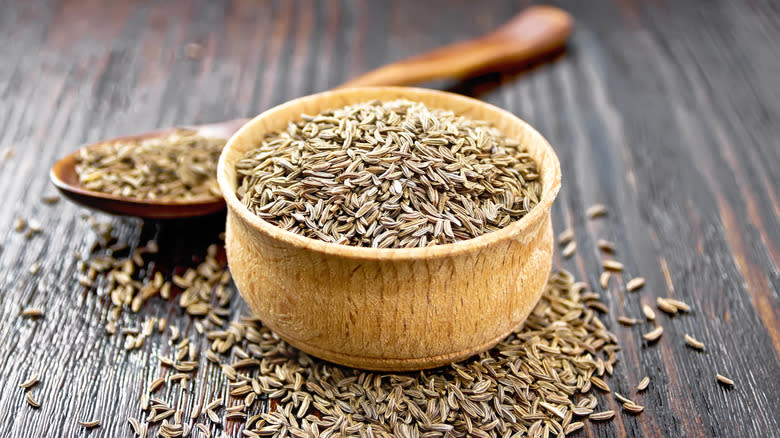
Another well-known ingredient used around the world, cumin seeds are also associated with Middle Eastern and Latin American cooking, but are perhaps the most popular spice in India where it has been used since ancient times.
Inamdar explains that, like mustard seeds, cumin seeds are excellent for tempering with oil and being added to dishes. In fact, they are frequently combined with mustard seeds for a lovely peppery, earthy flavor combo. He adds that this roasted combination is a favorite for chaats and buttermilk. Cumin has a familiar warm spice flavor with a little bitterness.
Tempered cumin seeds are used in vegetable and rice dishes much like mustard seeds. Also called "jeera," there are several popular namesake recipes that use cumin, such as jeera aloo (cumin potatoes) and jeera rice. As a ground spice it's one of the essential bases of many masala pastes, including garam masala, which means cumin seeds are a big part of most of your favorite curries. The chaats that Inamdar refers to are a whole category of Indian snack dishes and street foods. Chaats are incredibly diverse — using bases like crushed samosas, puffed rice, or fried potatoes — and a pungent sour and umami spice mix called chaat masala is a very common flavoring that uses cumin as a central ingredient.
Turmeric Powder
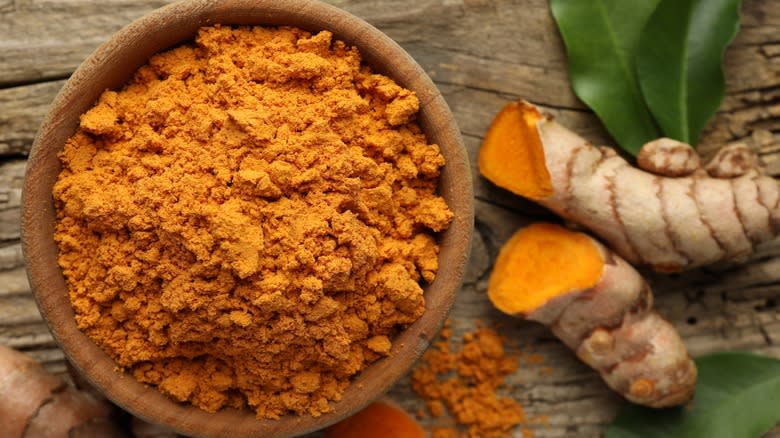
Turmeric powder is the dried form of a root that is related to ginger and originates in India and Southeast Asia. As Inamdar says, "The world associates Indian cuisines with turmeric the most." However, it's not quite as ubiquitous as Western menus may have you think. Turmeric is a very powerful flavor; it's bitter and has a damp, earthy aroma to it, which can overwhelm dishes when too much is used. "We use it in moderation and never by the heaps as popularly shown in many food shows," the chef advises.
The popularity of turmeric may have grown in Western cooking recently due to its supposed anti-inflammatory properties, but in India it's a supporting player in masala spice mixes, not the primary focus of a dish. That said, its versatility means it shows up in many popular Indian meals. It's a key component in mixes like sambhar masala, which is used for a spicy vegetable stew, and tandoori masala, used for the well-known tandoori chicken and butter chicken, known as chicken makhani. Turmeric's association with Indian cooking also means it is used in Indian-inspired Western dishes like chicken tikka masala and ingredients like curry powder.
Red Chiles
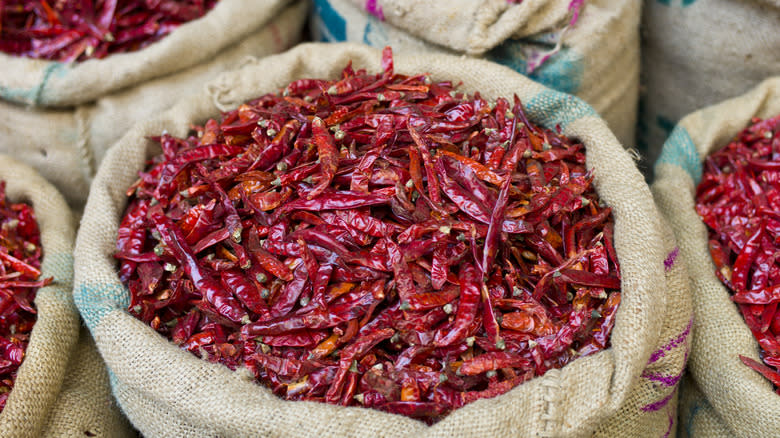
Inamdar explains that dried red chiles are used "whole and powdered for some heat and coloration." Despite originating in the Americas, India is now one of the world's largest consumers of red chiles, which are grown in hundreds of different varieties. While that level of diversity may seem overwhelming, there are a few popular styles that are most widely used. Kashmiri chiles, also called Kashmiri mirchi after the Indian word for chiles, are widely used, as is deghi mirchi, which blends dried Kashmiri chiles with other red peppers.
Some Indian peppers (like dhani mirchi, a variation on the bird's eye chile) are extremely hot; yet the most common powders are more mild — hitting the 1,000 to 2,000 range of the spice-measuring Scoville scale. In both flavor and heat these red chile powders are similar to paprika, imparting some spice and smokiness to dishes, in addition to the vibrant red color.
Red chiles are widely used in a huge variety of Indian recipes, but one of the most well-known dishes outside the country would be vindaloo. Chile powders are used as rubs on grilled and roasted meat, and are another essential part of tandoori dishes. You'll find Indian red chiles in stews, curries, and sauces, and they're even used as fillings and flavorings for baked goods like the Indian flatbread paratha. If you can't find these exact chiles and powders, Mexican pasilla chiles are a good substitute.
Garam Masala
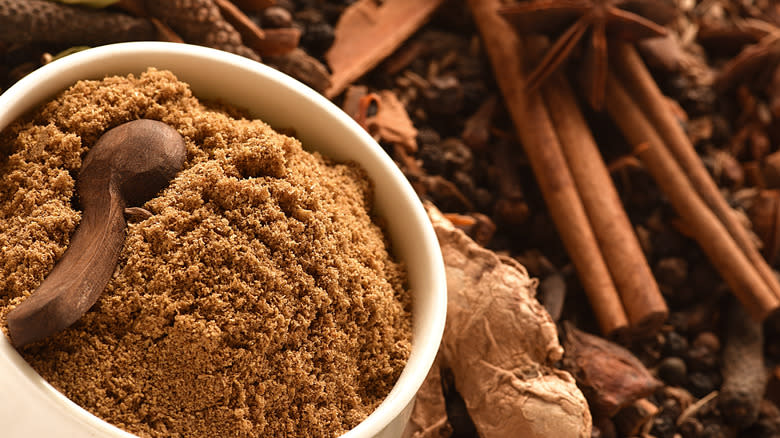
Perhaps the best known masala spice mix in the U.S., garam masala is widely available in most grocery stores. As Inamdar tells us, the spices used can be "whole and powdered, which may include the likes of black pepper corn, cloves , cinnamon sticks, Indian bay leaf, mace, nutmeg, green cardamom, and black cardamom." Garam masala comes in both powder and paste form, with powder being more used in northern India, and paste in the south.
Garam masala has lots of variations that can change by region and even family, but the name itself is a hint to its most essential flavors. The term in Hindi means "warm spices," but not warm as in fiery. Garam masala can be hot, but it's primarily earthy and a little sweet with a blend of cinnamon, cumin, nutmeg, cardamom, and mace as the central focus. If you make your own garam masala it's important to toast the spices whole before you grind them, which imparts smoky notes into the blend.
As with other Indian masalas, garam masala is used in stews, braises, and curries, or as a rub on meat and fish. Because of its widespread popularity, and the fact that it often gets combined with other spices, many common Indian dishes you might recognize use it, for example, butter chicken and the chickpea stew chana masala. The rice dish biryani, potato dish aloo gobi, and paneer curry frequently incorporate garam masala.
Coriander Seeds
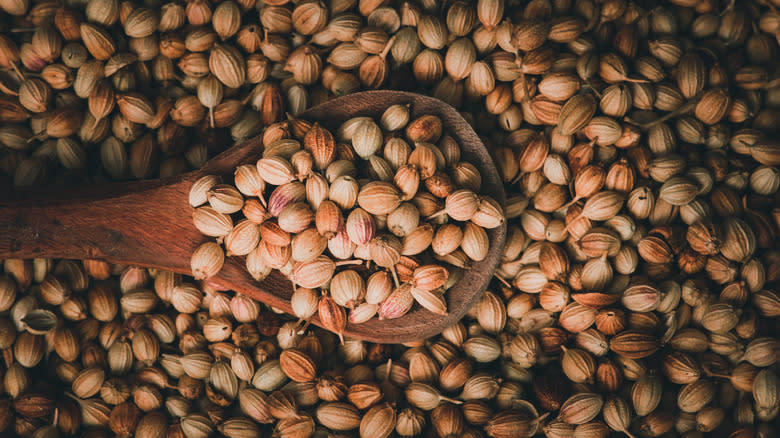
Coriander seeds are actually the dried fruit of the cilantro plant, and have become one of the most popular spices worldwide. Coriander is part of the same family that includes cumin, a flavor it's often paired with. According to Varun Inamdar, Indian cuisine uses coriander "for the citrusy earthy notes." While many spices used in Indian masalas and dishes are warming or even hot, coriander brings a nice brightness and a floral flavor that helps round out recipes. While other spices like turmeric may be more associated with Indian cooking, coriander is a real workhorse and may be the most used individual spice in the country.
More so than with almost any other ground spice, if you're making an India masala, you're almost certainly using coriander. Garam masala, tandoori, and biryani masala all used coriander. It's also used in chana masala and the chaat masala for Indian street food. It will show up in many popular types of curry like madras and vindaloo. If you plan on making your own masala mixes from scratch, coriander is truly essential, and the seeds should be toasted before you grind them.
Fenugreek Seeds
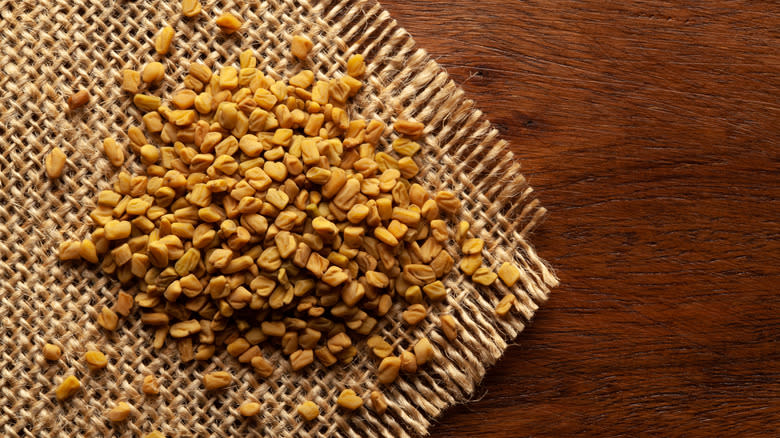
Fenugreek seeds may be lesser known to people starting out with Indian cooking, but if you've ever made some curry and wondered why it didn't taste quite like the one from your favorite Indian restaurant, fenugreek is probably the answer. Inamdar says that fenugreek seeds are "for that clearly identifiable bitter bite in chutneys, jams, curries, and pickles." Fenugreek is a plant used in both Indian and Middle Eastern cuisines that is related to chickpeas and peanuts. While both the leaves and seeds are edible, it's the brown pebbly seeds that are most used in Indian cooking. The taste of fenugreek is incredibly distinct, having a mix of strong bitterness and sweetness. The sweet aspect of fenugreek is commonly compared to maple syrup, especially once it starts to cook. If you want to cut down on the bitterness, the hard seeds can be soaked before being used.
The first place you'll want to add fenugreek seeds is in your garam masala or other masala mixtures. It's likely the secret ingredient that will finally make it pop the way you want. Because of its sweetness fenugreek is used to balance out mild earthy ingredients like potatoes and lentils, or to temper spicy curry dishes. It gets used in paneer curries, and makes a great addition to give depth to chutneys, pickles, and marinades. Just make sure to start small when adding fenugreek seeds to Indian recipes, as the flavor can be overwhelming.
Ginger Powder
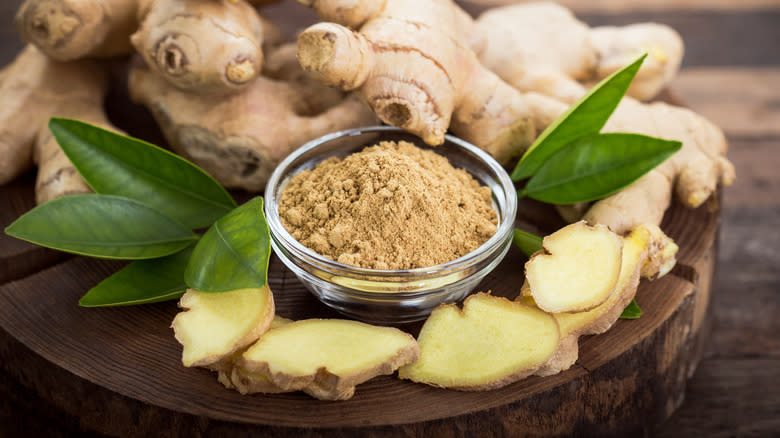
Ginger is a prominent flavor in Indian cooking, often used in paste form either by itself or mixed into a garlic-ginger paste. However, powdered ginger can be substituted for fresh to lend a warmer, softer flavor to Indian dishes; there are even traditional dishes where powder is the preferred form. Chef Inamdar notes that along with fennel, ginger powder is particularly used in Kashmir, the mountainous northern region that has been heavily influenced by neighboring regions in Central Asia. Unlike the bright and spicy flavor that fresh ginger brings, ginger powder will be richer, with a sweet fruity flavor, while still maintaining a mild peppery bite.
Ginger powder is added to most Kashmiri versions of classic Indian dishes, like paneer masala, along with recipes more directly associated with Kashmir, like the goat curry rogan josh. It's also used in unique dishes like nadur yakhean, which is lotus root in a yogurt curry, or substituted for fresh ginger in recipes like the north Indian curry dum aloo and rista, a meatball dish in gravy. Finally, you'll use ginger powder with many other Indian ingredients on this list in a variety of masala spice mixes like chaat and tandoori.
Fennel Powder
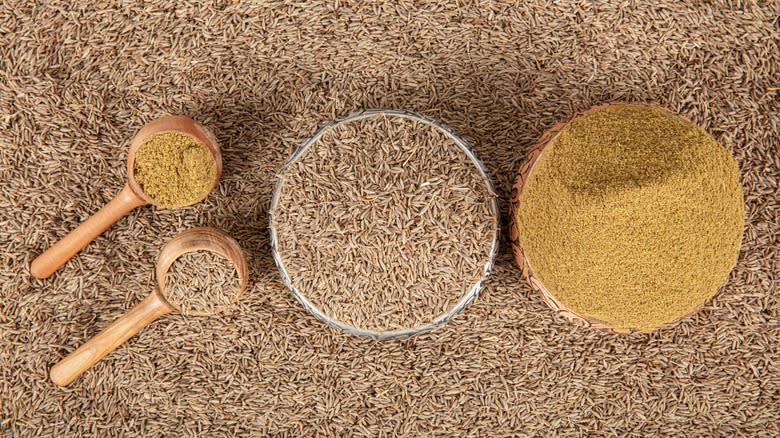
As Inamdar explains, fennel powder is the other ingredient besides ginger powder that makes Kashmiri-style cuisine unique. Ground from whole fennel seeds, fennel powder has the same anise/licorice flavor associated with the seeds. It's a mildly sweet flavor, especially when toasted and ground, and can be used to balance out more spicy flavors in dishes like curry. Beyond their use as a flavoring agent, fennel seeds and powder have long been celebrated in India for their medicinal properties, where they are believed to be beneficial for digestion. Candy-coated fennel seeds are a popular after-dinner snack, similar to a mint.
Because fennel is paired with ground ginger, it gets used in many of the same recipes like rogan josh and dum aloo. However, it is still used as an addition in spice mixes around the country, like the southern Indian chettinad masala, madras curry, and some versions of biryani. Fennel's flavor profile pairs well with meats, but it's popular in Indian desserts too; it can even be used as a flavoring in drinks like chai.
Saffron
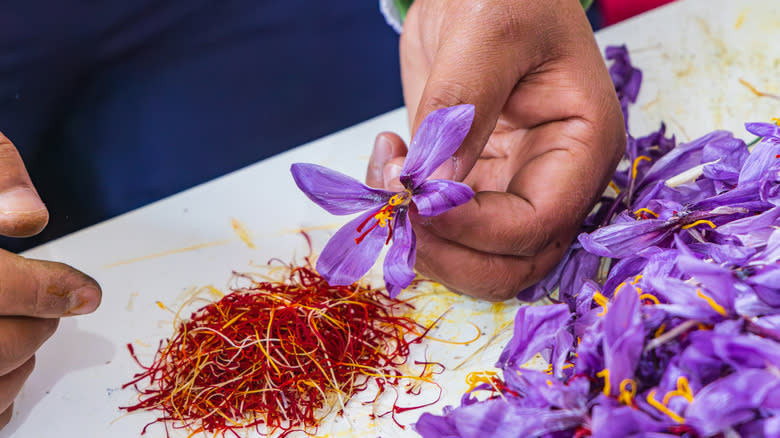
Saffron doesn't need much introduction, but Inamdar wants to emphasize that, "Yes, it is a spice and a sweet and fragrant one at that." Most people in the U.S. know saffron for being the most expensive spice by weight in the world. It comes from the saffron crocus, which originated in the Mediterranean, but is now cultivated widely in India as well. Saffron is made from the stigma of the flower, and is so expensive because it has to be hand-picked in a very labor-intensive process that can only happen during a brief window when the flower is open. Saffron has a unique, complex, floral, and honeyed flavor. While it is expensive, it can be quite intense and thus is used in small quantities, making it worthwhile to invest in as part of your journey with Indian cooking.
Inamdar mentions that saffron is "best for curries, rice, mithai, and desserts." Saffron is usually soaked in water or milk, which draws out the flavor and adds to the coloring potential of the spice. While saffron is used in plenty of dishes, its most famous role may be in biryani and other Indian rice dishes, where it gives those recipes their distinct yellow coloring. The mithai Inamdar refers to is a category of Indian sweets, and saffron is a popular dessert flavor. Small thumbprint cookies called peda are one popular example, and then there's rasmalai, a sweet cheese dish that uses saffron-infused cream.
Read the original article on Tasting Table.


